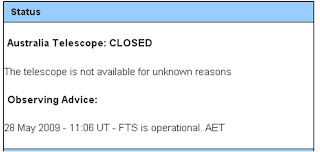
Yesterday and today we have been using and observing with the Southern Faulkes telescope. Above is a product of our microlensing experiment. However, there have been a few hiccups along the way...
The first problem was confusing Greenwich Time with Greenwich Summer Time. When we booked the telescope, the time was UTC(coordinated universal time) . We found out that UTC is the same as Greenwich, but we aren't Greenwich. We're Greenwich Summer Time. We also learned about the Julian Day system. Every day in every calendar is unified by the Julian Day. Today is JD 2454964. It is a simple way for astronomers to stop confusion when talking about dates using different calendars.
To read more...
en.wikipedia.org/wiki/Julian_daySo, all that means is we had an extra hour to prepare.
We checked out the OGLE recommended target list to find out what we'd be observing, and the exposure times for each target, etc. From there we also got a star finder map with the the light curves made up from other astronomers data. Our observations of the targets from the OGLE list are automatically transferred to the light curves, if the targets names are entered correctly. We hope that a planetary microlensing event will occur during our time observing.
We also had to check to see if the stars were visible at the time. We used the
Staralt website to do this.
This website is very useful as it tells you when the stars are visible, and where in relation to the moon they are. This is important, because if the moon is too close, the telescope will not let you observe. It can also change the quality of of the observations.
When we took control, we started out filling in (accurately) the RA and DEC (like the longitude and latitude of the sky) and the OGLE name of the target. Then we move the telescope to point at the coordinates. We select the filter - Filter i'- and we chose the exposure times. They were mostly around 3 seconds, so it didn't take long. We re-exposed each target 3 times before moving on. This provides an even more accurate reading of the star.
On the Light Curve an accurate reading is a point, but when inaccurate, there is a line with the potential error. We hope to avoid this, as we are using a very strong telescope.
Today, however, we were unable to access the most recent target list, so our readings may not be as useful over all, but we coped with the various problems (internet access down, no target list) well. We also had enough time to make 25 observations, so we are pleased with the outcome.
We have also been granted our request for extra time. As part of our project we are allocated 90 minutes of telescope time, in 30 minute slots. However our project requires a lot of time, so we now have an extra 120 minutes.












) We went the to the astronomy center in the physics department in NUIG, along with our teachers Ms. Herbert and Mr. Ryder. There we met with our soon-to-be-mentor Gregg Hallinan, who had booked us a session on the Faulkes Telescope. We arrived early so we would be able to take the Real-Time Interface Demo and become familiar with the telescopes workings. In the demonstration we entered the names and coordinates of Saturn, Pal3 and the Eagle nebula and it showed us what the telescope would do and how the images would look if we had control of the telescope.
We went the to the astronomy center in the physics department in NUIG, along with our teachers Ms. Herbert and Mr. Ryder. There we met with our soon-to-be-mentor Gregg Hallinan, who had booked us a session on the Faulkes Telescope. We arrived early so we would be able to take the Real-Time Interface Demo and become familiar with the telescopes workings. In the demonstration we entered the names and coordinates of Saturn, Pal3 and the Eagle nebula and it showed us what the telescope would do and how the images would look if we had control of the telescope.

